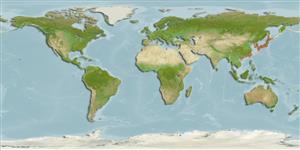Common names from other countries
Classification / Names / Names
Nomi Comuni | Sinonimi | Catalog of Fishes (gen., sp.) | ITIS | CoL | WoRMS
Environment: milieu / climate zone / depth range / distribution range
Ecologia
; salmastro; distribuzione batimetrica 0 - 6 m (Ref. 385). Subtropical
Northwest Pacific: from south of Japan to the south of Sakhalin.
Length at first maturity / Size / Peso / Age
Maturity: Lm ?, range 2 - ? cm Max length : 4.0 cm SHL maschio/sesso non determinato; (Ref. 127304); Età massima riportata: 10 anni (Ref. 127304)
Found in subtidal areas of estuaries in mud (Ref. 75831). Infaunal suspension-feeder (Ref. ).
Life cycle and mating behavior
Maturità | Riproduzione | Deposizione | Uova | Fecundity | Larve
Life cycle: Embryos develop into free-swimming trocophore larvae, succeeded by the bivalve veliger, resembling a miniature clam (Ref. 833).
SAUP Database. 2006. (Ref. 356)
IUCN Red List Status (Ref. 130435)
CITES status (Ref. 108899)
Not Evaluated
Not Evaluated
Human uses
Pesca: commerciale
FAO - pesca: landings, species profile | FishSource | Sea Around Us
Strumenti
Fonti Internet
Estimates based on models
Preferred temperature
(Ref.
115969): 5.6 - 22.6, mean 14 (based on 372 cells).
Resilienza
Alto, tempo minimo di raddoppiamento della popolazione meno di 15 mesi (K=0.2-1.11; tm=3; tmax=10).
Price category
Unknown.
